Decor
How Do You Celebrate Lunar New Year at Work?
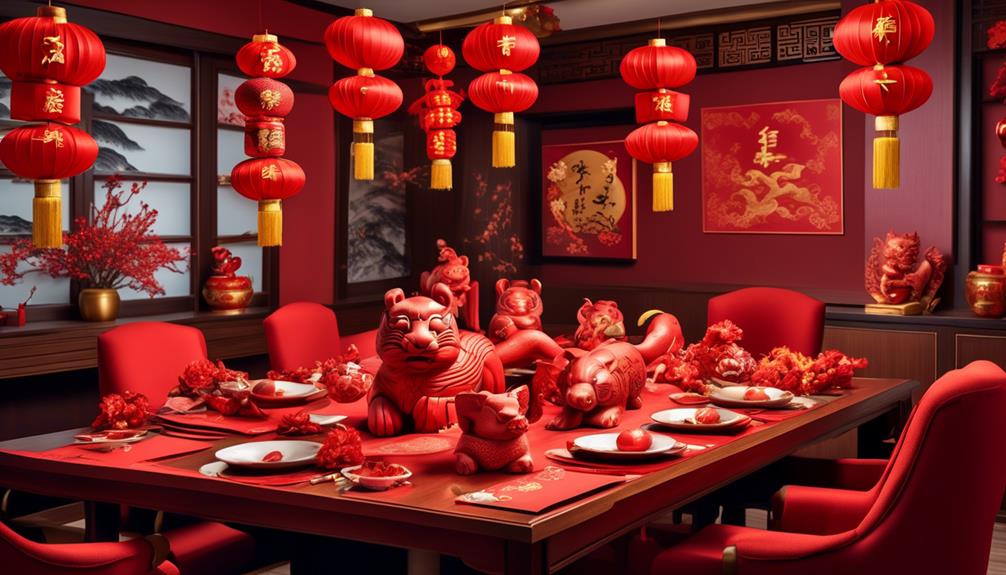
In our office, we are fortunate to celebrate Lunar New Year through numerous impactful methods.
This festive occasion allows us to come together as a team and embrace the rich traditions and customs associated with this important celebration. We adorn our office space with vibrant decorations, creating an atmosphere of joy and prosperity.
During a delightful potluck lunch, we savor traditional dishes that reflect the diverse culinary heritage of our colleagues. Many of us choose to dress in elegant Lunar New Year attire, paying homage to our cultural roots. Additionally, we exchange red envelopes, spreading good fortune and well wishes amongst one another.
By engaging in cultural workshops and charitable initiatives, we foster a deeper understanding and appreciation for the significance of this auspicious occasion.
Finally, we culminate our celebrations with a grand company-wide gathering or party, where we revel in the spirit of unity and camaraderie.
Key Takeaways
- Transform the workplace with vibrant Lunar New Year decorations and create a festive atmosphere that honors traditions and customs.
- Encourage employees to bring dishes inspired by Lunar New Year traditions and foster camaraderie and cultural exchange through food.
- Embrace the tradition of wearing traditional Lunar New Year attire to symbolize unity and cultural celebration in the workplace.
- Share personal stories, traditions, and recipes to deepen understanding and respect for different cultures and enhance employee morale and teamwork.
Decorate the Office Space
To create a festive and culturally immersive environment, we can adorn the office space with vibrant Lunar New Year decorations. This simple act of transforming the workplace brings a sense of excitement and celebration to the entire team. Collaborative crafts can be organized, allowing employees to come together and create beautiful decorations that reflect the spirit of the Lunar New Year.
The office space transformation not only adds visual appeal but also serves as a reminder of the significance of this important cultural event. By incorporating traditional elements such as red lanterns, paper cutouts, and Chinese zodiac symbols, we can create an atmosphere that honors the traditions and customs associated with the Lunar New Year.
The process of decorating the office space can also foster a sense of unity and teamwork among colleagues. Through collaboration and creativity, employees can work together to design and execute the decorations, promoting a shared sense of ownership and pride in the workplace.
Moreover, the office space serves as a reflection of the company's commitment to diversity and inclusion. By embracing and celebrating different cultures, organizations demonstrate their respect for their employees' backgrounds and traditions.
Organize a Potluck Lunch
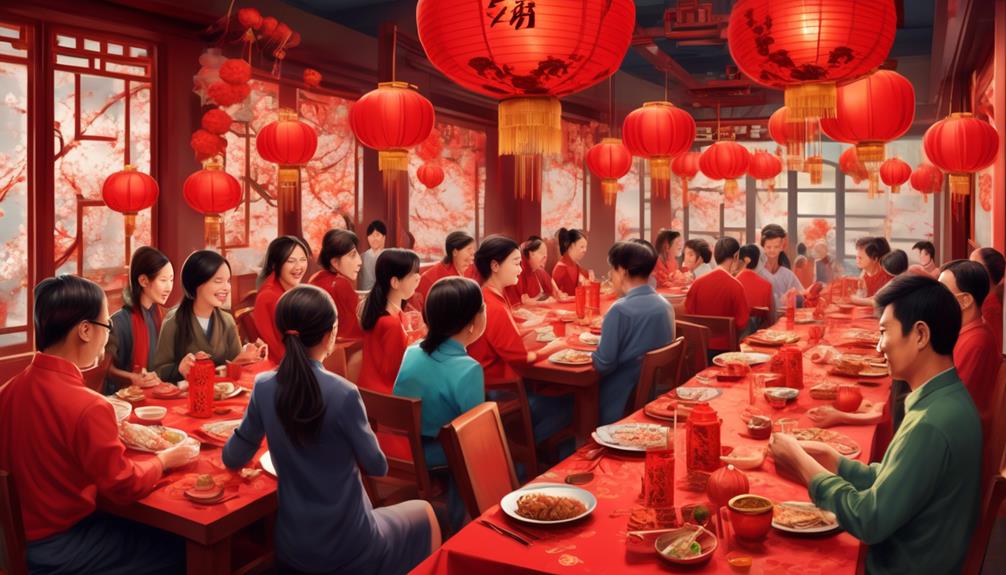
We can enhance the Lunar New Year celebration at work by organizing a potluck lunch, where employees can come together to share and enjoy a variety of delicious dishes from different cultures. A potluck theme allows everyone to contribute and showcase their culinary skills, making the celebration more inclusive and diverse. It also fosters a sense of camaraderie and encourages employees to learn about each other's cultural backgrounds through food.
To ensure a successful potluck lunch, it's important to establish some guidelines. Encourage employees to bring dishes that are inspired by Lunar New Year traditions or are popular in their own cultures. This will create a dynamic spread of flavors and showcase the richness of different culinary traditions. Providing a sign-up sheet for employees to list the dishes they plan to bring can help avoid duplicates and ensure a balanced variety.
To make the potluck lunch even more special, consider providing employees with a collection of potluck recipes inspired by Lunar New Year celebrations. This can include classic dishes such as dumplings, spring rolls, or tangyuan, as well as modern interpretations or fusion dishes that blend different culinary influences.
Wear Traditional Lunar New Year Attire
When it comes to celebrating Lunar New Year at work, one of the ways we can embrace the festive spirit is by wearing traditional Lunar New Year attire.
Dressing for prosperity isn't only a way to honor our cultural heritage, but it also brings a sense of joy and unity to the workplace.
Dressing for Prosperity
For a touch of prosperity in the workplace, consider embracing the tradition of wearing traditional Lunar New Year attire. Dressing for success isn't just about looking good, it's also about honoring our cultural heritage and bringing positive energy into the workplace.
Traditional Lunar New Year attire, with its vibrant colors and auspicious symbols, symbolizes prosperity and good fortune. By donning these traditional garments, we can create a sense of unity and celebration in the office. Not only does it show respect for our culture, but it also fosters a positive and festive atmosphere.
Wearing traditional Lunar New Year attire is a way to connect with our roots and bring luck and prosperity not only to ourselves but also to our colleagues. Let's embrace this tradition and dress for prosperity this Lunar New Year.
Embracing Cultural Diversity
With a vibrant display of colors and auspicious symbols, embracing the tradition of wearing traditional Lunar New Year attire in the workplace not only honors our cultural heritage but also fosters a sense of unity and celebration among colleagues.
By embracing cultural diversity, we create an inclusive and welcoming environment where everyone feels valued and respected.
Wearing traditional Lunar New Year attire is a powerful way to showcase our cultural identity and promote cultural sensitivity in the workplace. It allows us to share our traditions and customs with our colleagues, fostering a deeper understanding and appreciation for different cultures.
This act of inclusivity at the workplace not only enhances employee morale but also strengthens teamwork and collaboration.
Spreading Festive Cheer
To spread festive cheer and honor our cultural heritage, we proudly don traditional Lunar New Year attire in the workplace, creating a vibrant and celebratory atmosphere among colleagues. By wearing traditional Lunar New Year attire, we not only express our individual cultural identities but also foster a sense of unity and cultural appreciation within the workplace.
Here is a glimpse of how we spread joy and celebrate this auspicious occasion:
- Colleagues adorned in elegant qipaos and vibrant hanboks, showcasing the beauty of Chinese and Korean traditions.
- Men dressed in sharp and sophisticated Tang suits and traditional Vietnamese ao dai, bringing a touch of cultural diversity.
- Decorations such as red lanterns and auspicious symbols displayed throughout the office, adding a festive touch and spreading the joy of Lunar New Year.
Through our attire and decorations, we create an inclusive and celebratory environment that encourages cultural understanding and appreciation among colleagues.
Exchange Red Envelopes
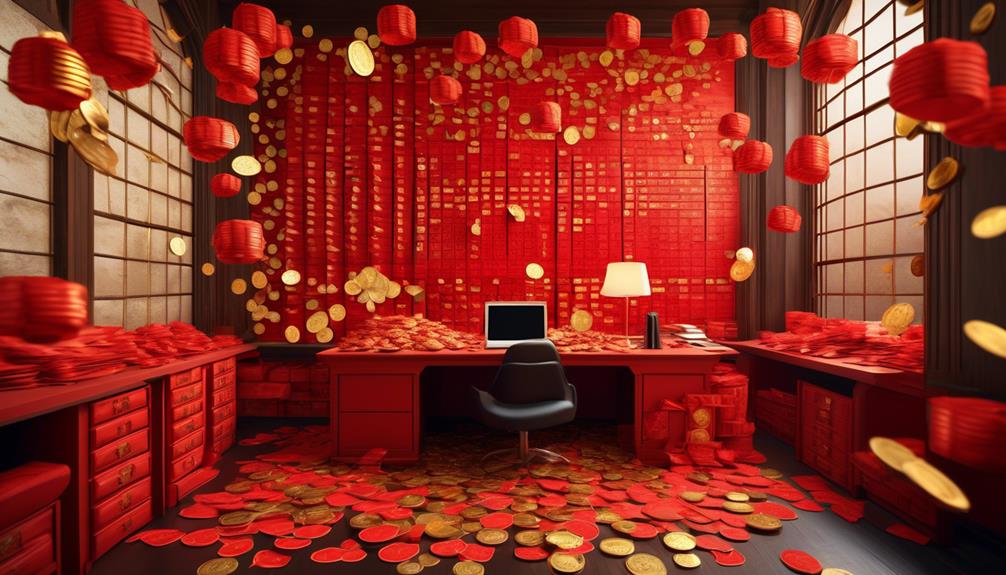
During Lunar New Year celebrations, it's customary in many Asian cultures to exchange red envelopes as a gesture of good luck and prosperity. The tradition of giving and receiving red envelopes, also known as 'hongbao' in Chinese or 'ang pow' in Malay, holds great significance. The red color symbolizes good fortune and warding off evil spirits, while the amount of money inside represents prosperity for the recipient.
The exchange of red envelopes isn't only a way to spread festive cheer, but it also allows colleagues to connect on a deeper level and learn about each other's cultural customs. By participating in this tradition, individuals have the opportunity to exchange cultural gifts and gain a better understanding of the importance of Lunar New Year in Asian cultures.
It is essential to approach the exchange of red envelopes with respect and cultural sensitivity. It's customary to give red envelopes to elders, supervisors, or those in higher positions as a sign of respect. Additionally, it's important to use new and crisp banknotes, as old, wrinkled, or torn money is considered inauspicious.
Display Cultural Artifacts and Symbols
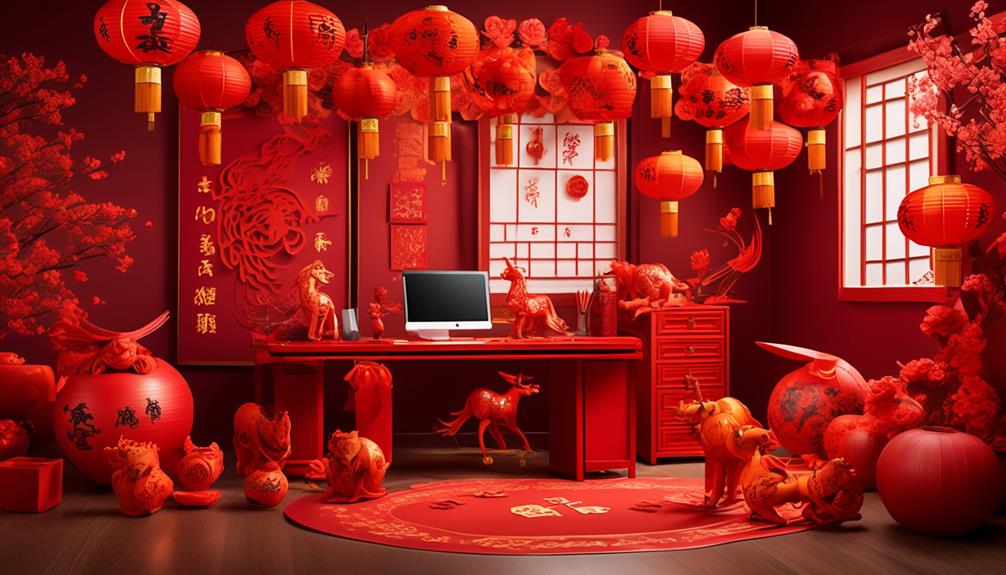
When celebrating Lunar New Year at work, it's important to create a festive atmosphere by displaying cultural artifacts and symbols.
Decorate your workspace with traditional items like lanterns, red banners, and paper cutouts of zodiac animals.
Showcase symbolic artwork, such as calligraphy or paintings that represent good fortune and prosperity.
Additionally, don't forget to display festive decorations like cherry blossoms or tangerine trees to bring luck and abundance into the workplace.
Decorate With Traditional Items
We can enhance the festive atmosphere by adorning our workplace with traditional items, showcasing cultural artifacts and symbols.
Here are some ideas to decorate with traditional items for Lunar New Year:
- Hang red lanterns and paper cuttings on the walls to symbolize good luck and ward off evil spirits.
- Display traditional Chinese paintings or calligraphy that depict auspicious themes such as prosperity, longevity, and happiness.
- Set up a small altar with offerings of fruits, candies, and traditional food like dumplings, which symbolize wealth and good fortune.
Showcase Symbolic Artwork
To further immerse ourselves in the festive spirit of Lunar New Year, we can now explore the captivating world of symbolic artwork and showcase cultural artifacts and symbols that embody the essence of this auspicious occasion. Symbolic artwork holds great meaning and significance in Lunar New Year celebrations, reflecting the rich cultural heritage and beliefs of the community. Through various artistic techniques and styles, these artworks convey messages of good fortune, prosperity, and harmony.
One example of symbolic artwork commonly seen during Lunar New Year is the Chinese paper-cutting, known as 'Jianzhi.' The intricate patterns and designs depict traditional symbols such as the dragon, phoenix, and the Chinese character 'Fu,' representing blessings and good luck.
Another significant artwork is the Korean 'Najeon Chilgi,' which involves the delicate process of inlaying mother-of-pearl onto lacquered surfaces. This traditional craft showcases beautiful motifs inspired by nature, such as flowers, birds, and symbolic animals.
Display Festive Decorations
One way to fully embrace the festive atmosphere of Lunar New Year at work is by proudly displaying an array of vibrant and culturally significant decorations that showcase various cultural artifacts and symbols.
Festive office decorations not only create a visually appealing environment but also serve as a means of cultural expression and celebration.
Here are some interactive team building activities that can be incorporated into the display of festive decorations:
- Arrange a collaborative art project where employees can contribute to creating a large mural or collage inspired by traditional Lunar New Year symbols.
- Set up a display of traditional cultural artifacts such as lanterns, red envelopes, and paper-cuttings, allowing employees to learn about their significance and engage in discussions.
- Organize a decoration competition, encouraging teams to design and create their own unique decorations, fostering creativity and teamwork.
Host a Lion or Dragon Dance Performance
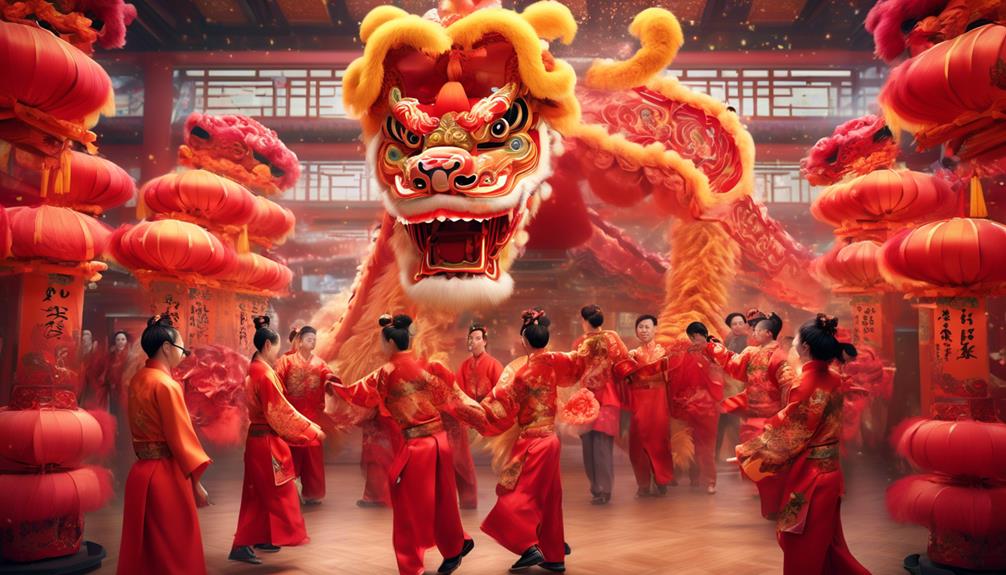
Hosting a vibrant and captivating Lion or Dragon Dance performance is a fantastic way to immerse employees in the joyful spirit of Lunar New Year. The rhythmic movements and vibrant colors of the lion or dragon evoke a sense of excitement and celebration. The performance is a visual spectacle that leaves a lasting impression on the audience.
To further enhance the experience, traditional music performances can accompany the dance. The melodious sounds of instruments such as the guzheng, pipa, and erhu create a harmonious atmosphere, transporting the audience to the heart of Chinese culture.
Incorporating a Lion or Dragon Dance performance into the workplace can be done by hiring a professional dance troupe or even inviting local community groups to perform. The performance can take place in a designated area or even weave through the office space, bringing the festive energy to every corner.
To help you visualize the magic of a Lion or Dragon Dance performance, here is a table showcasing the emotions that can be evoked:
| Emotion | Description | Example |
|---|---|---|
| Excitement | A feeling of anticipation | The sound of drums quickens the pace of the dance. |
| Joy | A sense of happiness | The vibrant colors of the lion bring smiles to everyone's faces. |
| Wonder | A feeling of awe | The acrobatic movements of the dancers leave the audience in awe. |
| Unity | A sense of togetherness | The rhythmic beats of the drums create a sense of unity among the audience. |
| Festivity | A celebration atmosphere | The energetic dance and music fill the room with a festive vibe. |
Hosting a Lion or Dragon Dance performance at work not only adds a touch of cultural authenticity to the Lunar New Year celebration but also creates a memorable experience for employees. It is an opportunity to showcase the richness of Chinese traditions and bring colleagues together in the spirit of joy and unity.
Plan a Team-Building Activity

After experiencing the vibrant and captivating Lion or Dragon Dance performance, it's essential to continue fostering a sense of unity and teamwork among employees by planning a team-building activity. By engaging in team-building games and Lunar New Year crafts, employees can bond and develop a deeper understanding of each other's strengths and abilities.
Here are three exciting options for team-building activities:
- Traditional Chinese Puzzle Games: Encourage employees to work together to solve puzzles like tangrams or Chinese chess. These games require collaboration, critical thinking, and problem-solving skills, helping to strengthen relationships and improve communication within the team.
- Lantern Making Workshop: Organize a workshop where employees can create their own lanterns using traditional Lunar New Year materials and techniques. This activity promotes creativity, cooperation, and attention to detail, as participants work together to design and construct beautiful lanterns.
- Calligraphy Competition: Invite a calligraphy instructor to teach employees the art of Chinese calligraphy. After learning the basics, employees can compete in a friendly calligraphy competition, showcasing their newly acquired skills. This activity enhances focus, patience, and precision, while also fostering a sense of friendly competition and camaraderie among team members.
Learn About Different Lunar New Year Customs
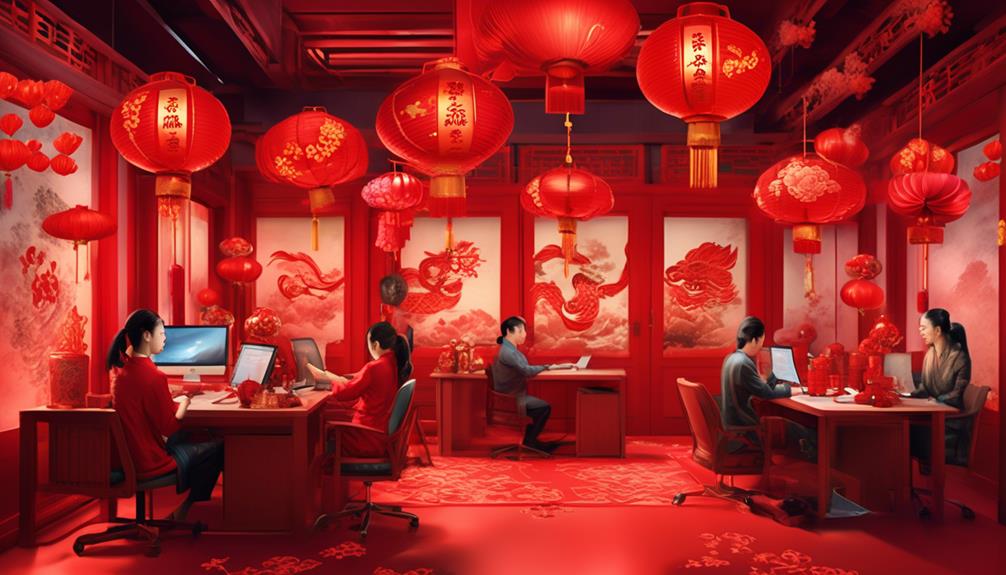
As we celebrate Lunar New Year at work, it's important to take the opportunity to learn about the various customs and traditions associated with this festive occasion. Lunar New Year isn't only a time for family reunions, but also a time to indulge in delicious Lunar New Year food and participate in traditional Lunar New Year games.
In many Asian cultures, Lunar New Year is celebrated with a variety of special dishes that hold symbolic meanings. For example, in China, dumplings are a popular Lunar New Year food because their shape resembles gold ingots, symbolizing wealth and prosperity for the coming year. Fish is also commonly served as it represents abundance and surplus. In Korea, tteokguk, a rice cake soup, is a must-have Lunar New Year dish that symbolizes good luck and the hope for a long life.
Aside from food, traditional Lunar New Year games play a significant role in the celebration. One popular game is the dragon dance, where performers carry a long dragon puppet and move in a synchronized manner to the beat of drums. This lively and vibrant dance is believed to drive away evil spirits and bring good luck for the year ahead.
Another traditional game is the exchange of red envelopes filled with money, known as 'hongbao' in Chinese culture. It's a gesture of good wishes and blessings for the recipient.
Share Personal Stories and Traditions
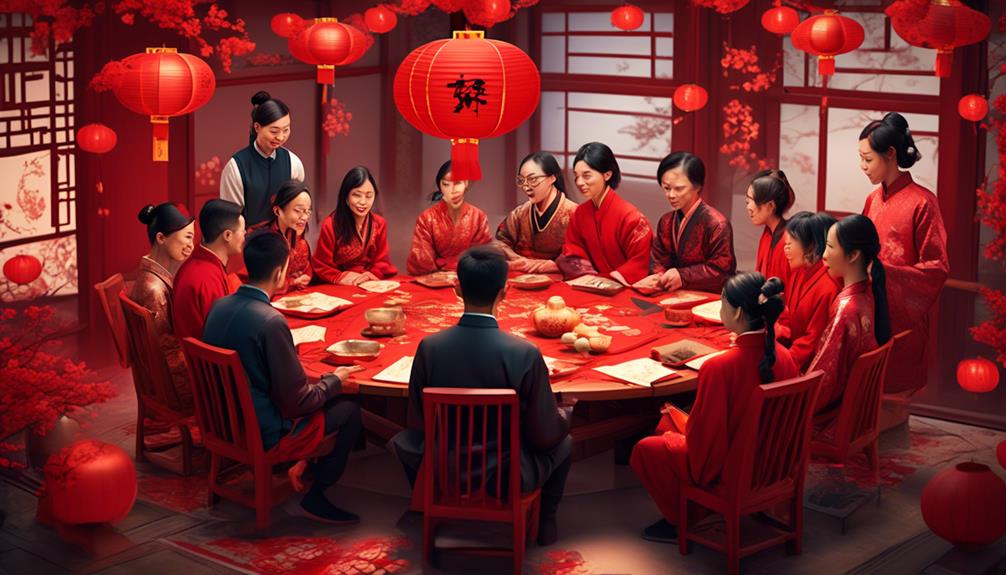
During Lunar New Year celebrations at work, it's a wonderful opportunity for colleagues to come together and share their personal stories and traditions. This not only fosters a sense of community and understanding but also allows us to learn from one another and appreciate the rich diversity of our cultures.
Here are some ways in which we can share our personal stories and traditions during Lunar New Year celebrations at work:
- Share recipes: One of the best ways to experience a culture is through its food. Encourage colleagues to bring in traditional Lunar New Year dishes and share the recipes behind them. This not only introduces us to new flavors and culinary techniques but also allows us to connect with our colleagues on a personal level.
- Cultural performances: Organize a talent show or cultural performance where colleagues can showcase their talents and share traditional dances, songs, or musical performances. This provides a platform for individuals to express their cultural heritage and allows others to appreciate and learn about different art forms.
- Storytelling sessions: Set up a storytelling session where colleagues can share personal anecdotes and stories related to Lunar New Year. This can include childhood memories, family traditions, or even folklore and legends. Such sessions create a space for cultural exchange and deepen our understanding of each other's backgrounds.
Conduct a Cultural Diversity Workshop
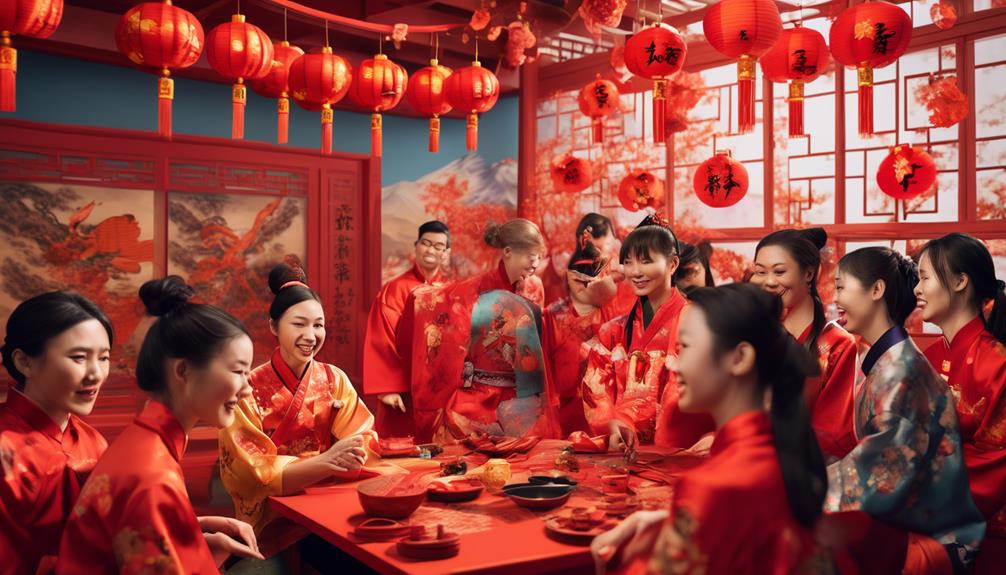
To further explore the rich diversity of our cultures and foster a deeper understanding among colleagues, we can now embark on the next step: conducting a Cultural Diversity Workshop.
This workshop aims to promote cultural sensitivity and inclusiveness in our workplace. By providing a platform for open dialogue and learning, we can create an environment where everyone feels valued and respected.
During the workshop, we'll delve into various aspects of cultural diversity, such as customs, traditions, and beliefs. Through interactive activities and discussions, participants will have the opportunity to share their own experiences and gain insights into different cultures.
We'll also explore the importance of cultural awareness in fostering effective communication and collaboration among colleagues.
The workshop will be facilitated by experts in the field of cultural diversity, ensuring that participants receive accurate and up-to-date information. They'll guide us in understanding the nuances of various cultures and help us develop strategies for fostering inclusiveness in our daily interactions.
Participate in a Calligraphy or Paper Cutting Workshop

Let us immerse ourselves in the artistry and cultural significance of calligraphy or paper cutting by participating in a workshop that will deepen our understanding and appreciation of these traditional crafts.
Here are three ways this workshop can help us master the intricacies of calligraphy and paper cutting:
- Engage in a calligraphy competition: By participating in a friendly calligraphy competition, we can challenge ourselves to showcase our skills and creativity. This competition won't only allow us to learn from each other but also foster a spirit of healthy competition and camaraderie.
- Witness a paper cutting demonstration: Watching a skilled artist demonstrate the delicate art of paper cutting will give us a firsthand experience of the meticulous techniques involved. We'll have the opportunity to observe the artist's precision, attention to detail, and artistic flair, inspiring us to elevate our own paper cutting abilities.
- Receive personalized guidance: In this workshop, we'll have the chance to receive personalized guidance from experienced calligraphy and paper cutting instructors. They'll share their expertise, offer valuable tips and techniques, and provide constructive feedback to help us refine our skills and enhance our understanding of these traditional crafts.
Participating in a calligraphy or paper cutting workshop won't only allow us to develop our artistic abilities but also deepen our connection to the cultural heritage of Lunar New Year. Let's seize this opportunity to immerse ourselves in the beauty and significance of these traditional crafts.
Collaborate on a Lunar New Year Charity Initiative
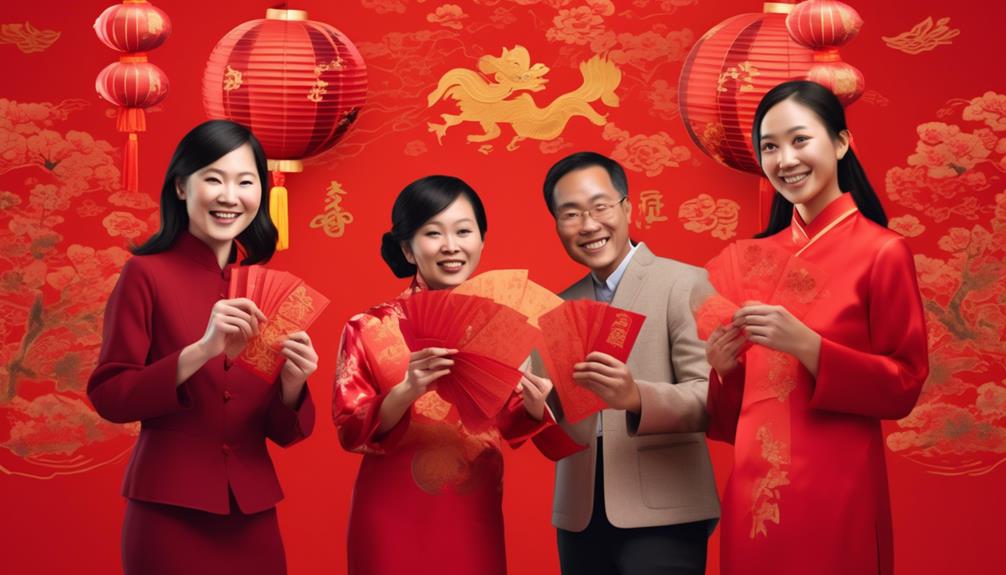
As we continue to explore the rich traditions of Lunar New Year, our focus now shifts towards collaborating on a meaningful charity initiative to celebrate this auspicious occasion.
One way to embrace the spirit of giving during this time is to collaborate on fundraising efforts and engage in community outreach.
Collaborating on fundraising allows us to pool our resources and make a greater impact. We can organize events like charity drives or bake sales, where the proceeds go towards supporting a cause that aligns with the values of Lunar New Year, such as helping underprivileged families or supporting education initiatives. By working together, we can maximize our contributions and make a positive difference in the lives of those in need.
Engaging in community outreach is another way to celebrate Lunar New Year through charity. We can organize volunteer activities or partner with local organizations to provide assistance to the vulnerable members of our community. From visiting nursing homes to distributing care packages, these acts of kindness not only bring joy to those in need but also embody the spirit of compassion and unity that Lunar New Year represents.
Celebrate With a Company-Wide Gathering or Party
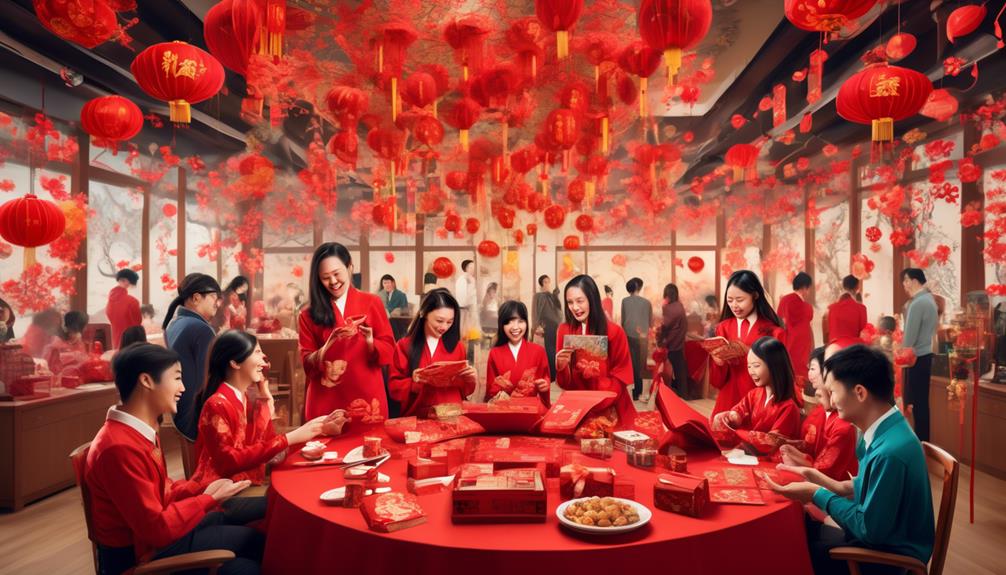
Our company-wide gathering or party is a vibrant celebration that brings together employees to honor the traditions of Lunar New Year. It's a time for us to come together as a community and embrace the rich cultural heritage of this auspicious occasion.
To paint a picture of this festive event, here are three sub-lists that capture the essence of our company's Lunar New Year celebration:
- Celebrate with virtual activities:
- We organize virtual games and quizzes that test our knowledge of Lunar New Year traditions and customs.
- Employees participate in virtual cooking classes, where we learn to make traditional dishes associated with the festival.
- We hold virtual performances, showcasing traditional music, dance, and storytelling to immerse ourselves in the cultural significance of the Lunar New Year.
- Organize a themed photo contest:
- Employees dress up in traditional attire or wear outfits inspired by the zodiac animal of the year.
- We encourage everyone to share their photos on our company's internal platform and vote for their favorite entries.
- The winners receive prizes that highlight the spirit of the Lunar New Year, such as red envelopes with symbolic gifts.
- Enjoy a virtual feast:
- We coordinate with local restaurants to deliver Lunar New Year-themed meal packages to employees' homes.
- During the gathering, we virtually connect and enjoy the festive meal together, sharing stories and experiences.
- This virtual feast allows us to bond over food, even when physically apart, and create cherished memories.
Our company-wide gathering or party is a joyous celebration that embraces virtual activities, a themed photo contest, and a virtual feast. By coming together in this way, we honor the traditions of Lunar New Year while fostering a sense of unity and camaraderie among our employees.
Frequently Asked Questions
What Are Some Traditional Lunar New Year Foods That Can Be Included in a Potluck Lunch?
When planning a Lunar New Year potluck, it's important to include traditional Lunar New Year foods to celebrate the occasion. Some popular options include dumplings, spring rolls, and sticky rice cakes. These dishes symbolize good luck, prosperity, and longevity.
Incorporating these foods into the potluck not only adds cultural significance but also allows everyone to experience the rich flavors and traditions of this festive holiday. It's a wonderful way to bring people together and create a memorable celebration at work.
How Can Employees Learn About Different Lunar New Year Customs?
Employees can learn about different Lunar New Year customs through cultural workshops and language exchange programs. By participating in these activities, we can gain a deeper understanding of the traditions, rituals, and cultural significance of Lunar New Year.
These programs provide a platform for employees to engage with individuals from diverse backgrounds, fostering cultural sensitivity and promoting inclusivity in the workplace. Through these opportunities, we can celebrate and appreciate the rich customs of Lunar New Year while building a more diverse and inclusive work environment.
Are There Any Specific Guidelines or Recommendations for Wearing Traditional Lunar New Year Attire at Work?
When it comes to traditional lunar new year attire at work, there may be specific guidelines or recommendations to follow. It's important to be culturally sensitive and respectful while celebrating this occasion.
The recommended lunar new year outfit colors at work can vary depending on the specific cultural customs and traditions. It's advisable to do some research or consult with colleagues who are familiar with these guidelines to ensure that you're appropriately dressed for the occasion.
What Are Some Common Cultural Artifacts and Symbols Associated With Lunar New Year That Can Be Displayed in the Office?
When it comes to cultural decorations for Lunar New Year in the office, there are plenty of options to add a festive touch. From vibrant red lanterns to symbolic paper cuttings, these artifacts can bring luck and prosperity to the workplace.
Displaying traditional calligraphy with auspicious greetings or showcasing the zodiac animal of the year are also common ways to celebrate.
And let's not forget about festive attire! Wearing traditional clothes or accessories can create a joyful and inclusive atmosphere during this special time of year.
How Can Employees Participate in a Calligraphy or Paper Cutting Workshop During Lunar New Year Celebrations at Work?
To participate in a calligraphy or paper cutting workshop during Lunar New Year celebrations at work, we can organize interactive sessions where employees can learn and practice these traditional art forms.
By inviting skilled instructors and providing the necessary materials, everyone can have the opportunity to explore the beauty and intricacy of calligraphy and paper cutting.
This not only promotes cultural appreciation but also fosters creativity and teamwork among employees.
Such workshops can be a meaningful and enjoyable way to celebrate Lunar New Year in the workplace.
Can Lunar New Year be Celebrated in the USA and How?
The Lunar New Year can be celebrated in the USA with vibrant festivities in the best USA new year destinations like San Francisco, New York City, and Los Angeles. People can enjoy parades, dragon dances, and traditional feasts, while also visiting temples and taking part in cultural activities to ring in the new year.
Conclusion
Lunar New Year celebrations at work are out of this world!
From decorating the office space to exchanging red envelopes, wearing traditional attire to showcasing cultural artifacts, there's no shortage of ways to embrace this festive occasion.
And let's not forget about the delicious potluck lunches and engaging workshops that bring us closer together.
So, get ready to ring in the Lunar New Year with a bang and create lasting memories with your colleagues.
It's a celebration that's truly one for the books!
- About the Author
- Latest Posts
Introducing Ron, the home decor aficionado at ByRetreat, whose passion for creating beautiful and inviting spaces is at the heart of his work. With his deep knowledge of home decor and his innate sense of style, Ron brings a wealth of expertise and a keen eye for detail to the ByRetreat team.
Ron’s love for home decor goes beyond aesthetics; he understands that our surroundings play a significant role in our overall well-being and productivity. With this in mind, Ron is dedicated to transforming remote workspaces into havens of comfort, functionality, and beauty.
Decor
Master Antiquing With Chalk Paint in 5 Steps
Start your journey to mastering antiquing with chalk paint in 5 steps and transform your furniture into vintage treasures.
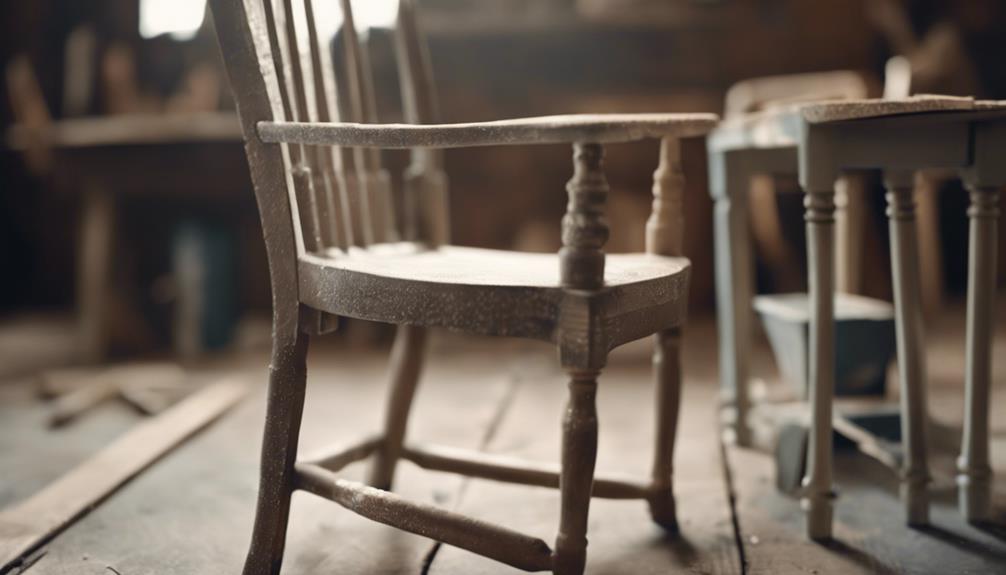
Master antiquing with chalk paint in 5 steps involves thorough surface cleaning, applying chalk paint in thin coats, distressing for a vintage look, sealing with a wax or polyurethane finish, and exploring different distressing techniques. Prepare by cleaning and sanding the surface, then choose high-quality paint and brushes for application. Experiment with dry and wet distressing, and seal the finish to protect against chipping and fading. For unique finishes, mix distressing methods and select the right sealant based on desired outcome. Mastering chalk paint antiquing takes practice and attention to detail, ensuring a beautifully aged furniture look.
Key Takeaways
- Choose high-quality chalk paint for best results.
- Apply thin, even coats for a smooth finish.
- Experiment with distressing techniques like dry or wet distress.
- Seal the finish with wax or polyurethane for durability.
- Practice and refine distressing skills for a masterful antique look.
Preparation
Before distressing furniture with chalk paint, we make sure to thoroughly clean the surface and lightly sand any rough spots for a smoother finish. This step is essential in achieving a professional-looking result.
Cleaning the furniture surface with White Lightning or TSP Degreaser helps remove any dirt, grease, or other contaminants that could interfere with the adhesion of the chalk paint. Using a lint-free cloth ensures that the surface is free of any residue that could affect the paint application.
Additionally, lightly sanding the furniture helps create a clean and smooth surface for the chalk paint to adhere to evenly. This process also helps remove any existing imperfections, ensuring a flawless final result.
Proper preparation sets the foundation for successful distressing with chalk paint, allowing for a more authentic and aged appearance.
After distressing, sealing the piece with a clear wax coat will protect the finish and enhance the overall look of the furniture.
Applying Chalk Paint
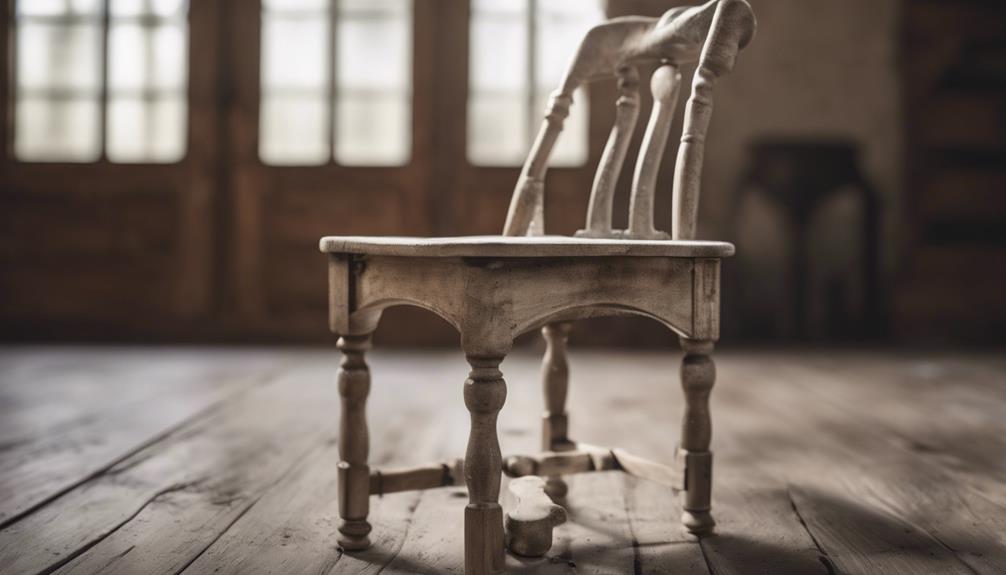
To achieve a professional finish with chalk paint, we recommend selecting a high-quality paint suitable for the specific furniture type.
When applying chalk paint, it's important to do so in thin coats to guarantee even application. Utilizing chalk paint brushes can help achieve better control and coverage.
It's vital to allow each coat of chalk paint to dry completely before applying the next one. This process helps prevent smudging and promotes a consistent finish.
Additionally, when starting a project, make sure you have enough chalk paint, typically a quart for larger pieces, to maintain color consistency throughout the furniture item.
Distressing Techniques
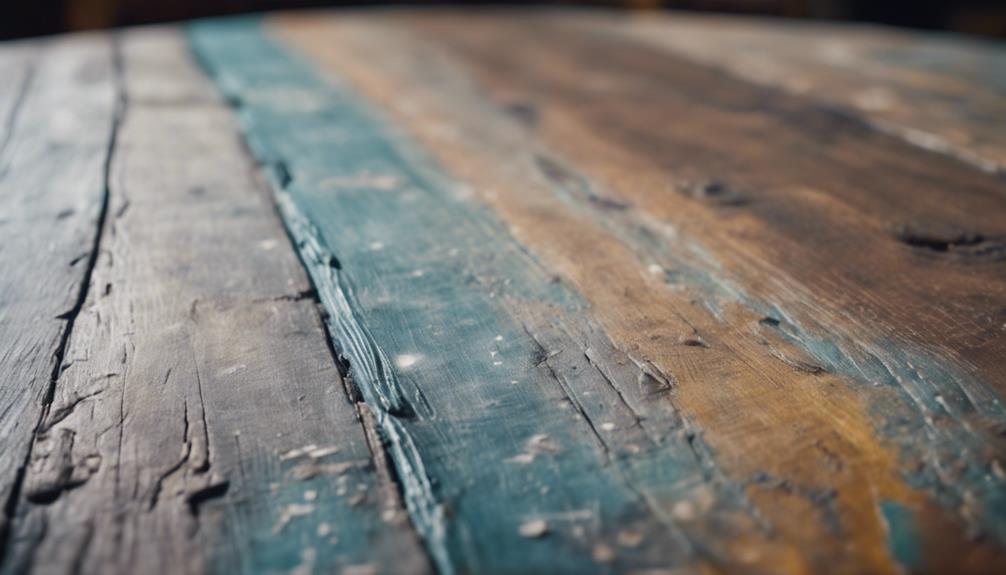
We can achieve various vintage looks by using different distressing techniques with chalk paint. Dry distress involves lightly sanding the chalk paint to reveal the underlying layers, creating a weathered appearance reminiscent of aged furniture.
On the other hand, wet distress requires wiping the chalk paint with a damp cloth to achieve a more natural, worn look. Wax distress, also known as the resist technique, utilizes wax as a barrier to create a subtle distressed effect on the furniture, adding depth and character to the piece.
Each distressing method offers a unique finish, allowing for experimentation and customization to achieve an authentic antique appearance. By trying out different distressing techniques, individuals can discover the method that best suits their desired vintage look.
Whether it's through sanding, wax resist, wet distress, or a combination of these methods, chalk paint provides a versatile medium for creating distinctive and aged finishes on furniture pieces.
Sealing the Finish

For achieving a durable and long-lasting distressed finish on furniture painted with chalk paint, selecting a high-quality clear wax or polyurethane sealant is essential. Applying a protective layer of sealant is vital to preserve the distressed look and prevent chipping or fading of the paint. It is recommended to apply the sealant in even coats to guarantee a smooth and lasting finish. Here is a comparison table to help you choose between wax and polyurethane sealants for your distressed furniture:
| Criteria | Wax Sealant | Polyurethane Sealant |
|---|---|---|
| Finish | Matte or Satin Finish | Glossy or Satin Finish |
| Durability | Requires Reapplication Over Time | Long-lasting and Durable |
| Application Ease | Easy to Apply, Buffing Required | Requires Thorough Application |
Both wax and polyurethane sealants offer protection and enhancement to your chalk-painted distressed furniture. Select the one that best suits your desired finish and maintenance preferences.
Chalk Paint Distressing Tips

Let's explore effective techniques for distressing chalk paint to achieve a vintage and worn look on furniture surfaces.
When aiming for a customized distressed finish, there are various distressing methods to choose from. Dry distress involves lightly sanding the chalk paint to reveal the base color underneath, offering a classic vintage appearance.
On the other hand, the wet distress technique includes wiping off the chalk paint with a damp cloth to create a natural worn effect.
For a more subtle distressed finish, consider using the wax distress or resist technique by applying wax to protect certain areas from paint.
Remember to protect the paint and preserve the finish by sealing distressed furniture with wax or polyurethane.
Frequently Asked Questions
How to Get an Antique Look With Chalk Paint?
To achieve an antique look with chalk paint, consider distressing techniques like dry distressing, wet distressing, or wax distress.
Dry distressing involves light sanding for a vintage appearance.
Wet distressing requires wiping the paint with a damp cloth for a natural worn look.
Wax distress, or resist technique, can create a subtle distressed effect on furniture.
Sealing the distressed piece with clear wax or polyurethane is essential to protect the finish and maintain the antique aesthetic.
How to Make Furniture Look Distressed With Chalk Paint?
To make furniture look distressed with chalk paint, we can use various techniques. Dry distressing involves lightly sanding the surface to reveal the base layer, creating a vintage effect.
Wet distressing entails wiping the paint with a damp cloth to expose the underlying color, achieving a natural worn look.
Wax distressing, known as the resist technique, uses wax to create a subtle distressed effect.
These methods offer unique ways to customize and achieve a distressed look with chalk paint.
How Do You Chalk Paint Step by Step?
We begin chalk painting by cleaning and lightly sanding the furniture surface.
Next, select a high-quality chalk paint and apply it in thin, even coats.
Explore different distressing methods such as dry, wet, or wax distress.
Finally, seal the distressed furniture with clear wax or polyurethane for protection.
Following these steps attentively guarantees a successful chalk painting project with a beautifully antiqued finish.
Do I Distress or Wax First?
We recommend distressing before waxing when working with chalk paint for an authentic aged appearance. Distressing creates texture and depth, enhancing the final antique effect once sealed with wax.
Applying wax over distressed areas not only protects the finish but also accentuates the distressed look. Waxing before distressing can complicate the process as the wax may interfere with sanding.
Distressing first allows for better control over the furniture's final appearance.
Conclusion
To sum up, mastering antiquing with chalk paint is a fulfilling process that can transform ordinary furniture into stunning pieces with character and charm.
As the saying goes, 'A piece of furniture is like a blank canvas waiting to be brought to life.'
By following these 5 steps, you can discover the full potential of chalk paint and create unique and beautiful pieces that will stand the test of time.
Happy antiquing!
- About the Author
- Latest Posts
Introducing Ron, the home decor aficionado at ByRetreat, whose passion for creating beautiful and inviting spaces is at the heart of his work. With his deep knowledge of home decor and his innate sense of style, Ron brings a wealth of expertise and a keen eye for detail to the ByRetreat team.
Ron’s love for home decor goes beyond aesthetics; he understands that our surroundings play a significant role in our overall well-being and productivity. With this in mind, Ron is dedicated to transforming remote workspaces into havens of comfort, functionality, and beauty.
Decor
10 Steps to Painting a Plastic Frame
Uncover professional tips for transforming plastic frames with paint, ensuring a flawless finish and lasting results.
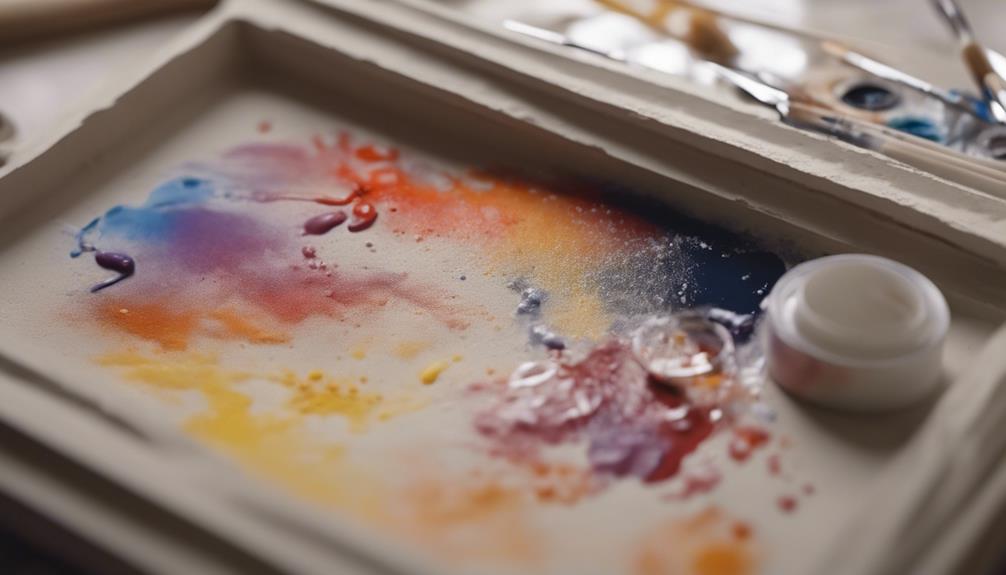
To paint a plastic frame effectively, start by selecting polypropylene or polyethylene frames. Clean thoroughly and lightly sand before applying a suitable primer. Use rubbing alcohol for a smooth finish, then mask off areas and apply even coats of paint with proper drying time. Add creative touches and seal with polyurethane for protection. This process guarantees a professional-looking result that lasts.
Key Takeaways
- Select plastic frames suitable for painting, avoiding PVC or polystyrene.
- Thoroughly clean and lightly sand the frame for adhesion.
- Apply a plastic-specific primer evenly after surface prep.
- Use painter's tape for clean lines and masking off.
- Seal with polyurethane for protection and finish longevity.
Selecting the Right Plastic Frame
When selecting a plastic frame for painting, make sure it's made of suitable materials like polypropylene or polyethylene for better paint adhesion. Different plastics have varying levels of compatibility with paint, so it's important to choose the right type to achieve best results.
Avoid using frames made of polyvinyl chloride (PVC) or polystyrene, as these materials may not allow the paint to adhere effectively, leading to peeling or flaking over time.
Certain types of paint may also work better with specific plastic frames. Checking the manufacturer's recommendations for the frame can provide valuable insights into which paints are most suitable for that particular material.
Opting for plastic frames specifically designed for painting can ensure a smoother process and a more professional finish.
Cleaning and Sanding the Surface

How should we prepare the plastic frame surface before painting to guarantee excellent adhesion and a smooth finish? To guarantee a successful paint job, follow these steps:
- Cleaning:
Begin by thoroughly cleaning the plastic frame to remove any dirt, dust, or grime. This step is vital as any impurities on the surface can affect the adhesion of the paint.
- Sanding:
Lightly sand the surface of the plastic frame to create a rough texture. This roughness provides a better grip for the paint, allowing it to adhere more effectively and prevent peeling or chipping.
- Primer:
Consider applying a suitable primer after cleaning and sanding the frame. A primer helps the paint adhere better to the surface and can also aid in achieving a smoother finish.
- Masking:
Before painting, make sure to mask off any areas of the frame that you don't want to paint. This step ensures clean and precise lines, giving your project a professional look.
Wiping Down With Rubbing Alcohol

We recommend wiping down the plastic frame with rubbing alcohol to guarantee proper adhesion and a smooth finish before painting. Rubbing alcohol plays a vital role in preparing the plastic surface for painting by effectively removing any dirt, oils, or residue that could hinder paint adhesion. This step ensures that the paint adheres well to the plastic surface, reducing the risk of peeling or flaking over time. The quick evaporation of rubbing alcohol leaves behind a clean and dry surface, ready for the next steps in the painting process.
To illustrate the importance of this step, let's take a look at the table below:
| Benefits of Wiping Down with Rubbing Alcohol |
|---|
| Removes dirt, oils, and residue from the plastic surface |
| Enhances paint adhesion for a smoother finish |
| Quick evaporation leaves a clean surface ready for painting |
| Prevents peeling or flaking of the paint over time |
| Effective and efficient preparation before priming or painting |
Masking Off Areas for Painting

When masking off areas for painting a plastic frame, it's essential to use painter's tape to guarantee clean lines and edges.
Make sure to press down firmly on the tape to avoid any paint bleeding onto unwanted areas.
Carefully mask off intricate details or sensitive parts to achieve a professional finish.
Taping off Edges
To achieve clean and precise lines in your painting, carefully use painter's tape to mask off areas of the plastic frame that you don't want to paint.
Here are some essential steps to follow when taping off edges:
- Prepare the Surface: Make sure the edges are clean and dry before applying the tape to promote adhesion and prevent paint seepage.
- Apply the Tape: Gently press the painter's tape along the edges of the areas you want to protect, ensuring it adheres firmly to the surface.
- Seal the Edges: Run your finger along the edge of the tape to secure it tightly to the plastic frame and prevent any paint from bleeding through.
- Double-Check: Before painting, inspect the taped-off areas to confirm that the edges are properly sealed and that there are no gaps where paint could seep under the tape.
Taking the time to tape off the edges meticulously will result in a professional and polished finish for your painted plastic frame.
Covering Sensitive Parts
Cover delicate parts like glass or hardware with masking paper or plastic before painting the plastic frame to protect them from unwanted paint.
When working on plastic frames, it's important to use painter's tape to mask off areas that shouldn't be painted. Make sure the painter's tape is firmly pressed down to create a tight seal and prevent any paint from seeping through.
In addition to using painter's tape, consider covering sensitive components such as glass or hardware with masking paper to safeguard them during the painting process. Taking the time to accurately mask off these areas will result in clean and precise paint lines, contributing to a professional-looking finish on your plastic frame.
Properly covering these sensitive parts is essential in achieving a polished and refined appearance for your painted plastic frame.
Applying a Suitable Primer
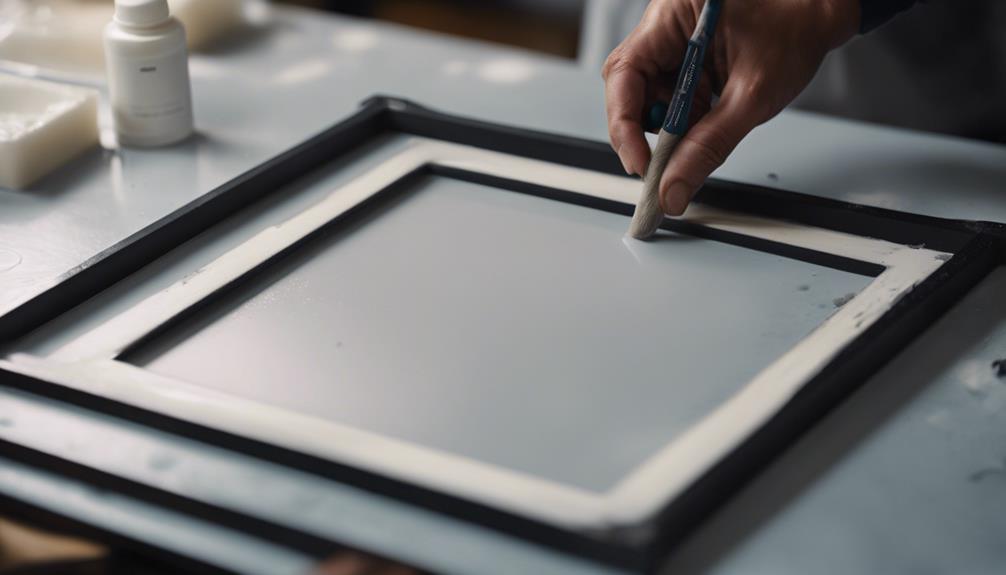
Let's kick off this step by prepping the plastic frame with a primer that's compatible with plastic surfaces. Here's what you need to know:
- Choose the Right Primer: Select a primer specifically designed for plastic frames to guarantee proper adhesion.
- Apply Evenly: Use smooth, consistent strokes to apply the primer evenly over the entire surface of the frame.
- Allow Sufficient Drying Time: Let the primer dry completely as per the manufacturer's instructions before proceeding with the next steps.
- Ensure Complete Coverage: Make sure the primer covers the plastic frame entirely to establish a strong base for the paint.
Using Appropriate Paint for Plastic

After preparing the plastic frame with a suitable primer, the next crucial step involves selecting the right paint specifically formulated for plastic surfaces.
When painting a plastic picture frame, it's vital to choose a type of paint that's designed to adhere to plastic materials. Using regular paints may result in poor adhesion, leading to peeling or chipping off easily. To guarantee a durable and long-lasting finish, opt for acrylic paint or other paints labeled for plastic surfaces. These specialized paints are formulated to bond effectively with plastic, preventing flaking and ensuring a smooth application.
Whether you prefer spray paints for a quick and even coverage or brush-on paints for more detailed work, selecting the appropriate paint for your plastic picture frame is key to achieving a professional-looking result.
Applying Even Coats of Paint
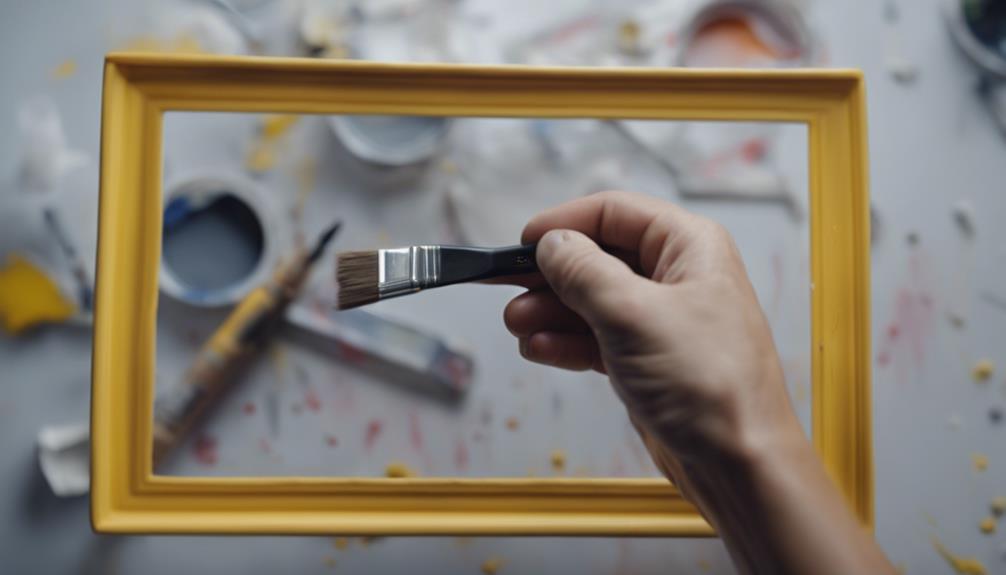
To achieve a smooth and professional finish on a plastic frame, it's essential to apply even coats of paint. When painting picture frames, following these guidelines guarantees a flawless result:
- Apply Thin and Even Coats: Each layer of paint should be applied thinly and evenly across the frame to prevent drips or uneven coverage.
- Allow Proper Drying Time: It's vital to let each coat dry before applying the next one. This helps the paint set correctly and adhere well to the plastic surface.
- Opt for Light Coats: Applying multiple light coats is preferable to a single heavy coat. This technique prevents clumping or streaking, resulting in a more uniform finish.
- Maintain Consistency: Consistency in paint application is key to achieving a uniform color and texture throughout the frame. Make sure to follow a systematic approach to ensure a professional-looking outcome.
Allowing Each Coat to Dry
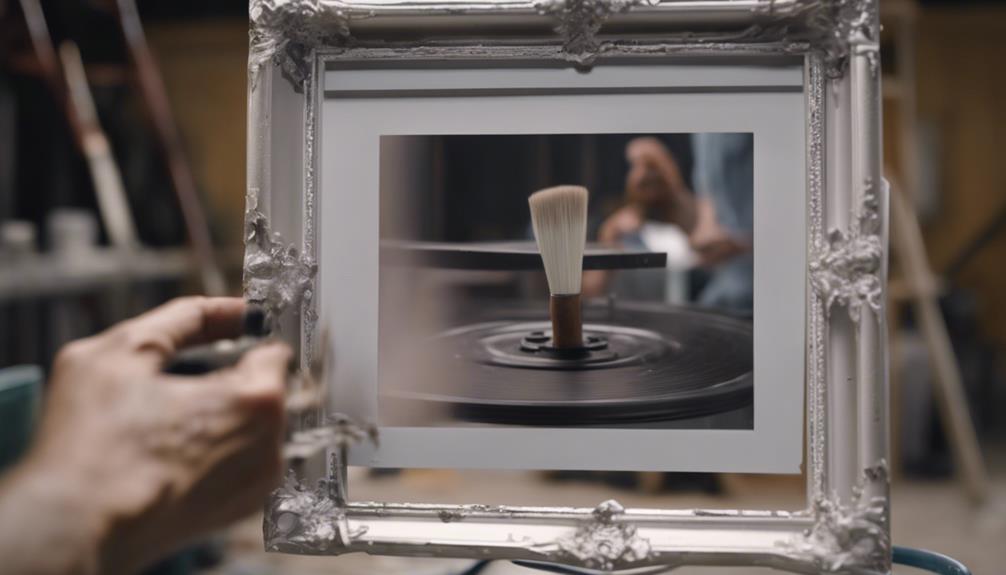
Guaranteeing that each coat of paint is thoroughly dried is a critical step in achieving a flawless finish on a plastic frame. By allowing sufficient drying time between coats, we can prevent potential issues like smudges, drips, or uneven application.
It's vital to follow the recommended drying times based on the type of paint utilized to secure the best results.
Patience for Drying Times
For best results, guaranteeing each coat of paint on the plastic frame dries thoroughly before applying the next coat is essential. Here are some key points to keep in mind:
- Prevent Smudging and Streaking: Allowing each coat to dry completely helps prevent unwanted smudges or streaks in the paint job.
- Refer to Manufacturer's Instructions: Drying times can vary depending on the type of paint used. Always refer to the manufacturer's instructions for specific guidance on drying times.
- Avoid Rushing the Process: Rushing the drying process can result in a less durable finish and potential imperfections. Patience is key for a flawless outcome.
- Achieve Professional Results: Patience during drying times ensures a smooth and professional-looking paint job on the plastic frame, leading to a high-quality and long-lasting finish.
Importance of Waiting
Allowing each coat of paint to thoroughly dry is crucial for achieving a flawless finish on a plastic frame. When painting a plastic frame, the significance of waiting between coats can't be emphasized enough.
Properly allowing each coat to dry guarantees that the paint adheres evenly, preventing issues like smudging, running, or uneven coverage. Rushing this process can lead to a less durable and professional-looking result, with potential peeling or chipping over time.
The drying time required between coats may vary depending on the type of paint being used, so it's essential to follow the specific instructions provided on the paint label. Patience is key in achieving a smooth and flawless paint job on your plastic frame.
Adding Touch-Ups and Details
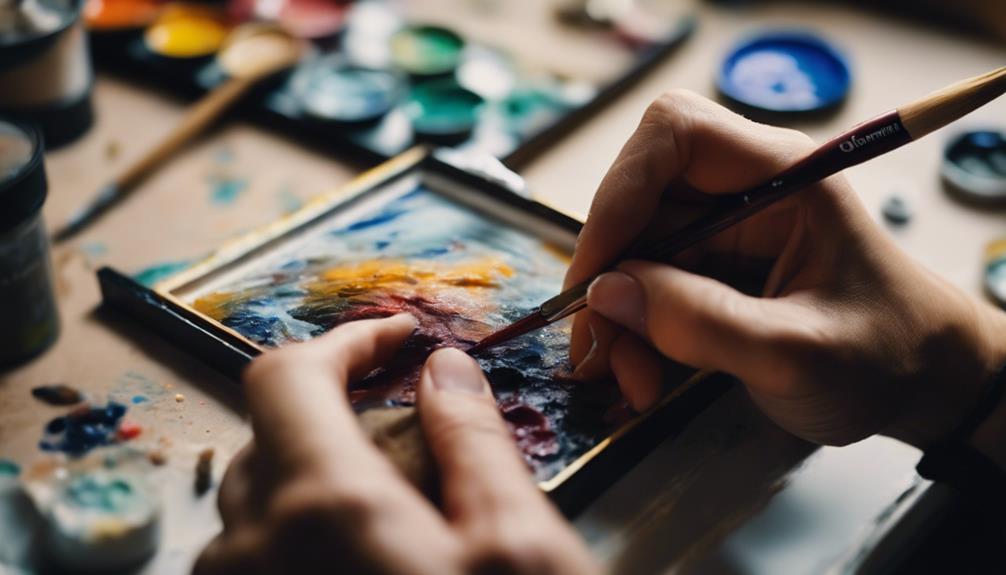
We often enhance the visual appeal of the painted plastic frame by adding intricate designs or patterns using acrylic craft paint on rubber stamps for a personalized touch.
To add that extra flair, here are some tips for detailing your plastic frame:
- Create Stencils: Make stencils from contact paper or use pre-made ones to easily incorporate decorative elements onto the frame.
- Antiqued Look: Apply acrylic paint or tinted glaze to achieve a vintage appearance, enhancing the frame's visual appeal.
- Metallic Touch: Experiment with gold or silver glaze for an elegant and luxurious finish.
- Creative Touches: Utilize stamps, painted designs, or rubbed-on color to elevate the overall aesthetic of the frame.
Sealing With Polyurethane
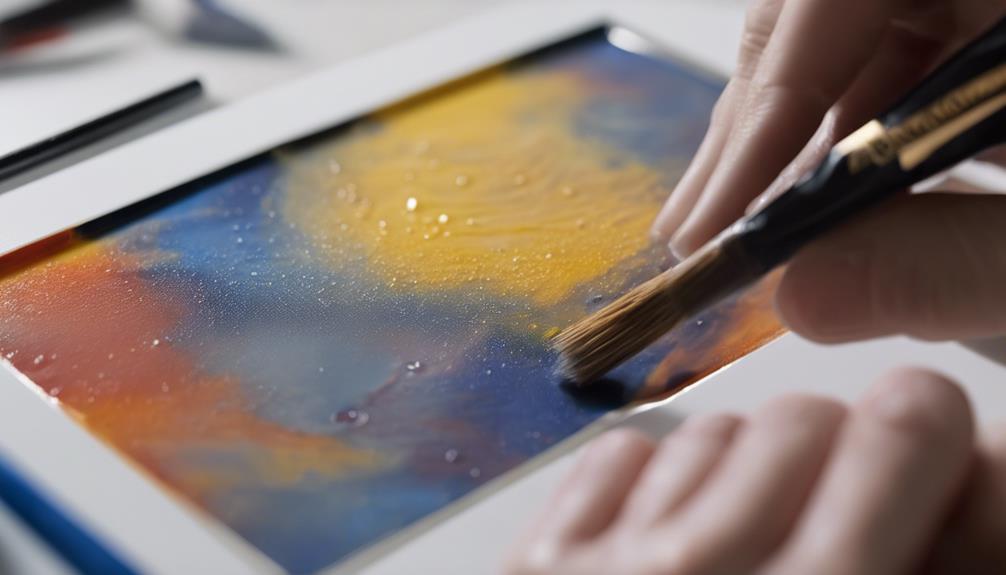
To protect and enhance the painted plastic frame, we recommend sealing it with polyurethane, a clear and durable sealant. Applying polyurethane over the painted surface not only provides protection against scratches, moisture, and UV rays but also helps to prolong the lifespan of the paint.
When selecting polyurethane, consider the different finishes available, such as matte, satin, semi-gloss, or glossy, to achieve the desired look for your frames.
To apply polyurethane effectively, make sure that the painted plastic frame has already received a coat of primer and is completely dry. Use a high-quality brush or foam applicator to apply thin and smooth coats of polyurethane to avoid streaks or bubbles. Allow each coat to dry thoroughly before adding additional layers.
Frequently Asked Questions
How to Paint a Plastic Frame?
When painting a plastic frame, proper preparation is essential. Sand the surface lightly and clean it with rubbing alcohol for better adhesion. Use a primer specifically formulated for plastic to make sure the paint sticks well.
Apply multiple thin coats of paint, allowing each layer to dry completely before adding more. Consider adding unique touches like stamps or antiquing for a personalized look.
Following these steps will result in a beautifully painted plastic frame.
What Paint to Use on Plastic Frames?
When painting plastic frames, it's important to select the right type of paint for excellent adhesion and durability. Utilizing paints specifically formulated for plastics guarantees a lasting finish.
Look for spray paints or brush-on craft paints labeled for plastic use. Consider using a plastic primer if the desired color is unavailable in the chosen paint type.
Adhering to these guidelines guarantees a successful painting project with vibrant and long-lasting results.
What Kind of Paint Will Stick to Plastic?
When considering what kind of paint will stick to plastic, it's important to choose a paint specifically designed for plastic surfaces. Regular brush-on or spray-on paints may not adhere well, leading to peeling or chipping.
Opt for spray paint formulated for plastic or use a plastic primer before painting to guarantee better adhesion. Acrylic craft paint can also be suitable for decorative purposes, but for a long-lasting finish, selecting the right plastic-specific paint is essential.
How Do You Prep Plastic for Paint?
When prepping plastic for paint, we must start by thoroughly cleaning the surface to remove any debris.
Light sanding helps the paint adhere better, and wiping with rubbing alcohol guarantees a clean canvas for painting.
Masking off areas we don't want to paint is vital.
Applying a suitable primer designed for plastic promotes paint adhesion and a smooth finish.
These steps are essential to achieve a professional-looking paint job on plastic surfaces.
Conclusion
In just 10 simple steps, you can transform a plain plastic frame into a personalized work of art.
By following these easy instructions, you can create a unique and custom piece that reflects your style and creativity.
So grab your supplies and get painting – the possibilities are endless!
- About the Author
- Latest Posts
Introducing Ron, the home decor aficionado at ByRetreat, whose passion for creating beautiful and inviting spaces is at the heart of his work. With his deep knowledge of home decor and his innate sense of style, Ron brings a wealth of expertise and a keen eye for detail to the ByRetreat team.
Ron’s love for home decor goes beyond aesthetics; he understands that our surroundings play a significant role in our overall well-being and productivity. With this in mind, Ron is dedicated to transforming remote workspaces into havens of comfort, functionality, and beauty.
Decor
How to Paint a Mirror Like a Pro in 3 Easy Steps
Find out how to transform your mirror into a masterpiece with these three easy steps that will elevate your space instantly.

Painting a mirror like a pro is simple in three steps. First, clean and trace the frame, then prime with gesso. Apply paint from the edges in thin layers using quality brushes. Opt for enamel or acrylic paint, allowing thorough drying between coats. Finish with sealant for protection. This process guarantees a flawless, professional look that enhances any space with elegance and style. Mastering these steps will help create a polished finish that transforms your mirror into a work of art.
Key Takeaways
- Use high-quality enamel or acrylic paint for a professional finish.
- Apply thin, even layers starting from the edges.
- Allow each coat to dry completely before adding another.
- Finish with a sealant or varnish for protection and longevity.
- Focus on details and take your time for a polished result.
Prepare Mirror Frame
Let's begin by cleaning the mirror frame with a soft cloth and window cleaner to remove any dirt or residue. Make sure to use rubbing alcohol or vinegar for tougher areas, guaranteeing the surface is completely clean before starting the painting process.
Once clean, trace the area to be painted on the mirror frame using a white soluble pencil for precise painting boundaries. This step is essential in achieving a clean and professional look for your mirror project.
Next, seal the mirror frame with white gesso as a primer to prevent paint peeling and ensure long-lasting results. This will create a smooth surface for the paint to adhere to, enhancing the durability of your design.
Additionally, consider using makeup pencils, white crayons, or fabric pencils for tracing intricate designs on the mirror frame before painting to achieve a detailed and polished final look. Make sure to take your time during this preparation process to guarantee a high-quality finish for your mirror frame project.
Apply Paint Evenly

To guarantee a smooth and professional finish, apply the paint evenly on the mirror surface using a high-quality paintbrush.
Here are some key tips to help you achieve a flawless coat of paint on your mirror:
- Start painting from the edges: Begin by carefully painting along the edges of the mirror frame before moving towards the center. This method ensures a consistent application and helps prevent any uneven patches.
- Work in thin layers: Avoid applying thick coats of paint as this can lead to drips and streaks on the mirror surface. Instead, opt for multiple thin layers, allowing each coat to dry completely before adding another one.
- Use a steady hand: When applying the paint, maintain a light touch and steady hand to achieve an even finish. This technique helps in creating a uniform look across the entire mirror.
Achieve Professional Finish
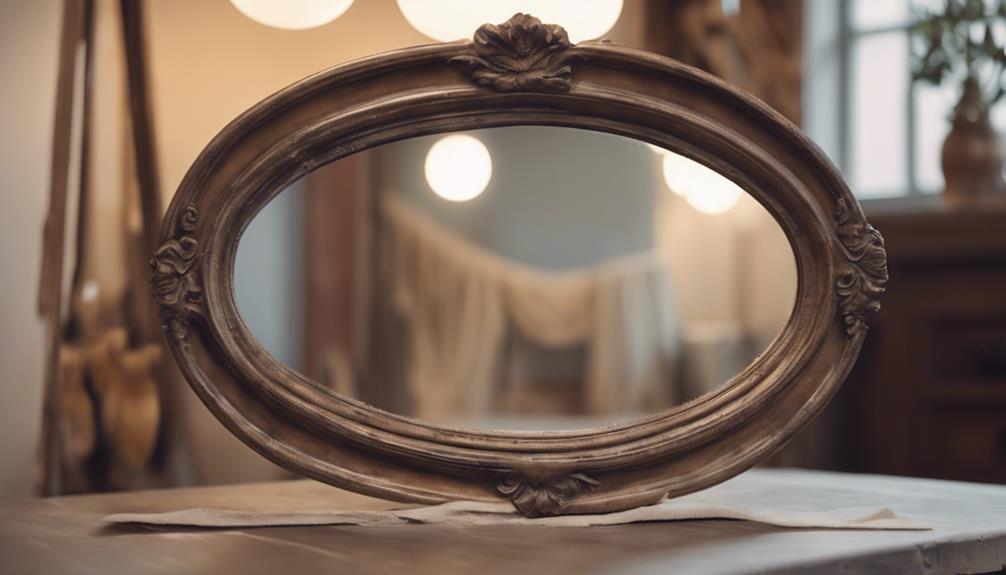
For a professional finish when painting a mirror, select high-quality enamel or acrylic paint specifically formulated for glass surfaces. To achieve a polished look, it is vital to apply thin coats of paint in even layers, allowing each coat to dry thoroughly before adding the next. This process guarantees a smooth and professional result on your painted mirror surface. Additionally, consider applying a sealant or varnish to protect the painted surface and enhance its longevity. Taking your time and paying attention to details will help you safeguard the painted surface and achieve a polished finish.
| Key Steps to Achieve Professional Finish |
|---|
| Choose high-quality enamel or acrylic paint designed for glass surfaces |
| Apply thin coats in even layers |
| Allow drying time between coats |
Frequently Asked Questions
How to Do Mirror Painting?
When tackling mirror painting, selecting the correct acrylic paint designed for glass surfaces is crucial. By seeking inspiration from TikTok artists, applying thin layers of paint, and ensuring each coat is dry before adding another, you can achieve a professional finish.
Seal the painted mirror with a varnish or sealant for durability. Experimenting with different painting styles and techniques is crucial for crafting a unique and creative mirror design.
How to Paint a Mirror to Look Vintage?
When aiming to paint a mirror for a vintage appearance, we recommend utilizing chalk paint for its ability to achieve a classic look.
Lightly sanding the frame before painting can enhance the vintage effect, while distressing techniques like dry brushing or layering can contribute to an aged appearance.
Consider applying dark wax or antiquing glaze to develop a vintage patina, resulting in a weathered finish that exudes a timeless charm.
How to Get Mirror Finish When Painting?
To achieve a mirror finish when painting, it's essential to use a high-quality mirror-specific paint. Make sure the mirror surface is thoroughly clean and free of any debris to prevent imperfections.
Apply thin, even coats of paint to avoid drips and streaks that can compromise the mirror-like appearance. Consider using spray paint for a more uniform finish and to prevent brush strokes.
Allow adequate drying time between coats for a flawless mirror-like finish.
How Do You Paint a Mirror Without Getting Paint on the Mirror?
When painting a mirror, we implement a meticulous approach to prevent any unwanted paint mishaps.
Careful preparation, like using painter's tape and paper to shield the mirror, is crucial. Selecting the appropriate paint type for the frame minimizes the risk of paint reaching the mirror.
Applying paint with precision and swiftly addressing any accidental spills on the mirror guarantees a flawless finish. Patience and attention to detail are key elements in achieving a polished result.
Conclusion
To sum up, painting a mirror like a pro may seem simple, but achieving that flawless finish requires attention to detail and patience.
So next time you pick up that paintbrush, remember to take your time and follow these steps carefully.
And who knows, maybe your mirror will reflect not just your image, but also your newfound painting skills.
Happy painting!
- About the Author
- Latest Posts
Introducing Ron, the home decor aficionado at ByRetreat, whose passion for creating beautiful and inviting spaces is at the heart of his work. With his deep knowledge of home decor and his innate sense of style, Ron brings a wealth of expertise and a keen eye for detail to the ByRetreat team.
Ron’s love for home decor goes beyond aesthetics; he understands that our surroundings play a significant role in our overall well-being and productivity. With this in mind, Ron is dedicated to transforming remote workspaces into havens of comfort, functionality, and beauty.
-

 Vetted3 weeks ago
Vetted3 weeks ago15 Best Contact Paper for Kitchen Cabinets to Elevate Your Home Decor
-

 Vetted2 weeks ago
Vetted2 weeks ago15 Best Poe Cameras for Home Security – Reviews & Buying Guide
-

 Vetted4 weeks ago
Vetted4 weeks ago15 Best Leather Restorer Products to Revive Your Furniture and Accessories
-

 Vetted3 weeks ago
Vetted3 weeks ago15 Best Drain Snakes to Unclog Your Pipes Like a Pro
-

 Beginners Guides4 days ago
Beginners Guides4 days agoI Inhaled Vinegar Fumes
-

 Vetted4 weeks ago
Vetted4 weeks ago14 Best Stationery Brands for Your Next Writing Adventure
-

 Beginners Guides2 weeks ago
Beginners Guides2 weeks agoSwinger Porch Light Color
-

 Mardi Gras Decoration3 weeks ago
Mardi Gras Decoration3 weeks agoWhy Does Hobby Lobby Not Do Mardi Gras?

























